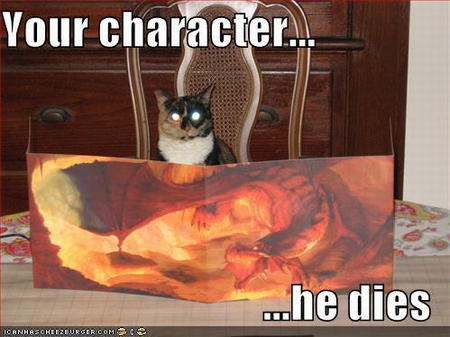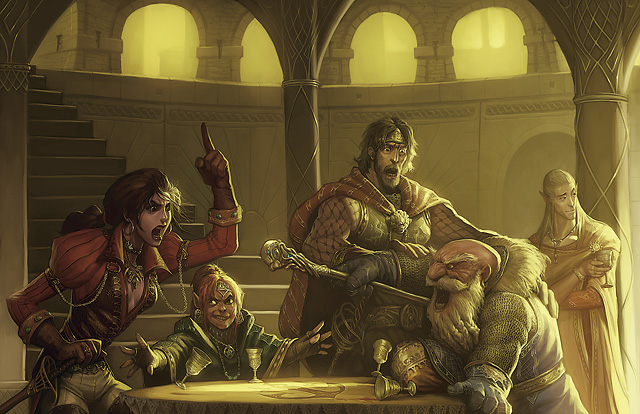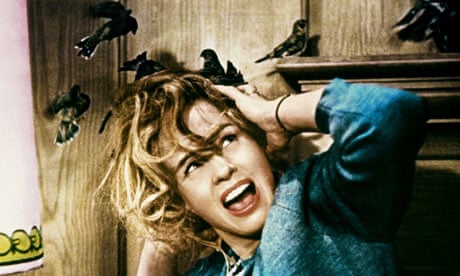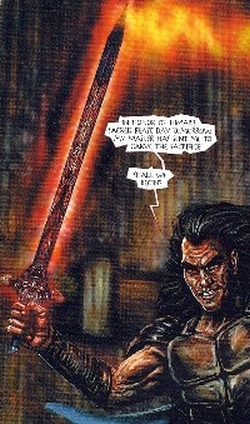
This book was, for quite some time, my favorite D&D splat. I think I liked it mostly for some ideas that I didn't often see in any other D&D books, even though I never really utilized anything in here. This book is a lot of fluff, and most of the mechanics listed are either geared deliberately toward the theme of the book (of course) or suggested alterations on existing mechanics. A lot of the fluff and advice can be found in countless articles and blogs online; and most it is pretty system agnostic. In fact, a lot of it runs counter to standard D&D games, and, frankly, falls apart in a standard D&D game.
So, that being said, lets delve into a D&D book that focuses pretty hard on playing not-D&D!
Introduction:
This is a one page blurb that gives a one paragraph outline of each chapter, and devotes two paragraphs toward describing 3.x's third attempt at a taint system. I'll get into taint more later, but given this book's love of grey-and-grey morality (also, more on that later), it seems really weird. We have a suggested rules changes to make alignment less deterministic, all while using a system that has very real consequences for [evil] acts, areas, and monsters.
They don't get into the authors until the end, but I might as well mention them up front. We've got James Wyatt, who is apparently the only D&D author. Joining the WotC team are Ari Marmell and C.A. Suleiman. I know nothing about either of them, except this is the first D&D book they each worked on.
Chapter 1: Dread encounters
We start out with an italic story about three of the iconic characters getting ready to right vampire spawn, but they're all DARKER and EDGIER than normal. Tordek's obviously been affected by taint (he has green flames in place of his sockets), and Mialee apparently needs to cut herself to get blood for her spells. Lidda's already out for the count, but I'm sure she's got lots of eyeliner and piercings, or something. Anyway, the vampire spawn get out of the way revealing that their master is (dun dun DUN), their old cleric pal, Jozan.

The idea's actually not bad. It seems odd to include the detail about Mialee taking a rather suboptimal prestige class from Complete Arcane, but whatever.
This chapter bounces around with a lot of headings about different things, but ultimately linked to introducing horror into the game. I suppose it's a good place to start. This chapter has lots of fluff to hopefully draw you into reading the rest, but the it is otherwise quite schizophrenic.
Stand-Alone Encounters
From what I am told, the stand-alone encounter is "the Platonic ideal of horror gaming".

Something like that.
What they're getting at is it's easier to be spooky for a little bit of time rather than a long time. As I find out later in the chapter, a "single encounter" is actually one or two pages of background text before the actual fight. It makes sense that you have to build up to it, but it's not the first thing that pops into my mind for "encounter".
Setting the Stage
We get some good advice about how this is really going to work if the players are on board with this. If everyone's always cracking Monty Python jokes, it's hard to run a horror game. You don't often see DM-player relationship advice in D&D books, so it's a nice change of pace. They suggest using dim lighting and/or music to set the atmosphere. I've never actually tried this, so I guess it depends on the group.
Creating Horror
Some more good advice on pacing and gradual reveals. The idea is to build tension slowly, with a few breaks here and there. We get an example story about the PCs investigating a house, getting increasingly creepy details before finding the mutilated bodies of the homeowners. They leave most of the dismemberment out, and they mention that heaping gore on gore can actually hinder things.
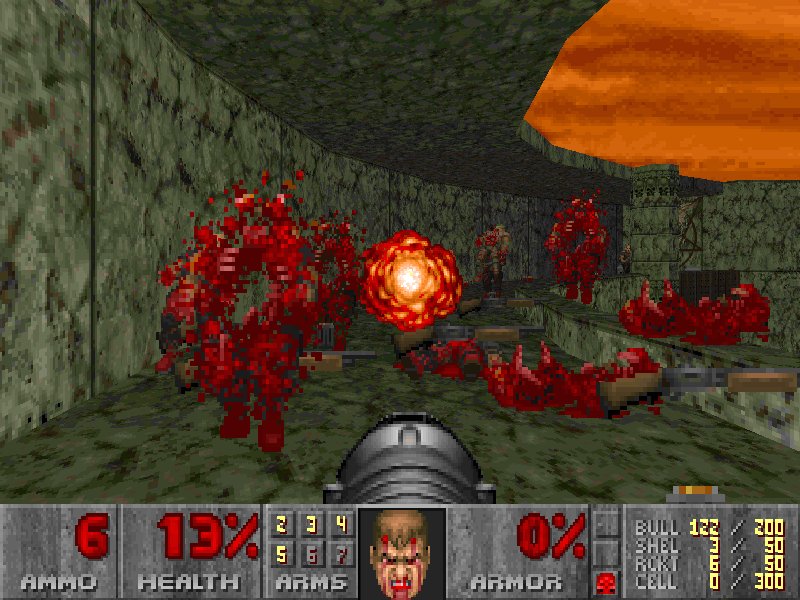
Feels like D&D, but not very spooky.
Another idea is to hit the players with the realization that the conclusion of the adventure is just the beginning of something worse. Thankfully they very explicitly state not to do this very often.
Horrific Ideas
We get four broad categories of things that can be used in horror, some better than others.
The Unknown: This idea is pretty good in abstract, but doesn't work too well for D&D. You use a monster the players don't know, to help minimize them from thinking of the monster like a stat-block that can be defeated with tactics and d20s. The book even mentions using obscure books to confound the players. How this interacts with the PCs making the appropriate Knowledge checks is wholly unstated.
The Unforgivable: Basically, the idea is to attack friends or loved ones of the PCs. This certainly can up the ante, but most of my players have a history of rolling badass loners. I can only see this type of tactic exacerbating the issue.
The Unexpected: Here, we throw unexpected consequences at the players after a session of murder hoboing. This can certainly go a long way to enforcing a grey-and-grey morality, and would have to involve a break from the norm of stabbing things and taking their shit. The specific example they use is pretty nice (stopping the BBEG from killing people, only to find out he's been sacrificing them to hold back a greater evil). Of course, if done wrong, or too much, the game devolves into Metal Gear Solid, where you realize at the end that the only winning move is not to play. Fffffff----
The Unthinkable: This is a specific call-out to grey-and-grey morality. Later chapters will include optional alignment rules, for obvious reasons.
Creepy Effects
We're treated to a good page-and-a-half table of creepy things. The book explicitly says not to linger on any of these for too long; they're just for mood setting. Knowing my players, any deviation from the norm will result in 45 minutes of Search checks, investigations, and going off the trail to figure out what the fuck is happening. I guess know how ADD your players are before using any of these.
Some are very mundane, that could be used to good effect (a wolf howling, a single window of a fine house boarded up for no obvious reason, or fog). The problem with a lot of them is that they could indicate the presence of an invisible creature and/or magical effect (flames flicker with no wind, hearing moans under ground in a cemetery, or footsteps echo with no obvious source). I can tell you damn well what my players would do: they'd spend 45 minutes looking for that non-obvious source, then get pissed at me for having the (obviously real) threat escape with no dice rolls or chance of being caught.
The Villain of a Horror Encounter
We get a list of around a dozen different monsters and villains from various books and movies. Anyone from Grendel to the Terminator. We also get "just about every James Bond" villain, noted for their "over-the-top" antics.
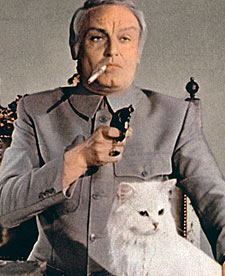
Witness the horror
Inside the Numbers
The first bit of advice here is to throw the PCs against a monster with a much higher CR than they can handle, and count on the players metagaming, so they'll get scared. Strictly speaking, I see what they're getting at, but I see this ending in one of three ways:
- The players don't get it and the PCs all die.
- The players get it and run, but don't come up with a way to defeat the monster, possibly leading to confusing or anger.
- The players know exactly how dangerous a troll is at 1st level, run away screaming, and come back on horses with flaming arrows and kite that motherfucker into oblivion.
There's also stuff about doing unorthodox things to throw people off, and some good advice about putting the PCs in unusual and hindering environments. Of course, most of the environment challenges listed are very low level. The notable exception is the DM's ever-favorite rule-breaking Antimagic Field, cuz reasons.
This actually brings up a rather important point about the book: most of the advice seems geared toward low-level adventures. Since we've known for years that D&D doesn't really function at high-level, it's not surprising that affects horror campaigns. Still, the book has a, perhaps deliberate, reluctance to discuss this. There's a bit in a later chapter about ways to alter certain types of magic to better suit a horror game, but they don't really ever deal with the sheer myriad of problems a 10th level caster can just solve in any given six seconds.
Unusual Villains
This is more of a list of different types of scenarios you can use to add urgency or dread to an adventure. We get countdowns, weird body horror, being trapped, and any of the above, but also with a monster.
Villainous Traits
Just over a page list of random physical traits or mannerisms to make villains more off-putting. This is a lot like Fields with Style in the Tome of Fiends, but typically smaller effects.
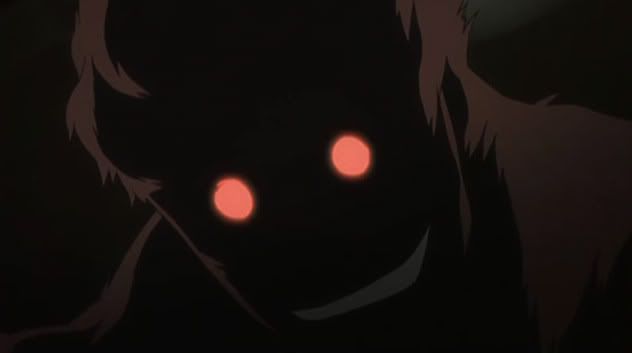
"I dunno. Should we trust him?"
Sample Encounter: to Grandmother's House
This isn't so much of an "encounter" as about a full page setup followed by a pretty brief encounter. The basic idea is that there is a cottage eight miles out from the town. Finding this cottage involves a DC 10 Search or Survival check, or the help of a local. A whole bunch of kids have gone missing (several, recently) and the PCs are going to investigate! The exact number of missing kids isn't stated, but apparently no one in the town has been able to track them this whole time.
On your way to the house, things get spooky (hearing the sounds of crying kids instead of animals in the woods, seeing the reflections of screaming kids in the lake). The optional taint rules are in effect, the closer you get to the place; the lingering evil around here is causing all of this fucked up shit.
Once you get there, you find out that a grey jester (new monster in the book) has been draining kid's Cha scores and turning them into slaves, all while a green hag eats them while they're still alive. You're encouraged to try and subdue the kids, who will otherwise fight to the death, even if the other monsters are slain. I could see this being a good horror encounter, if run well, apart from the whole "no one else found them the whole time" part.
Sample Encounter: Annalee's Baby
A baby! We know this one's gonna be edgy!
So, for whatever reason, the PCs arrive at the village of Eastbrook. The map looks almost exactly like a beetle. I'm guessing that's on purpose, but the layout of the 20 or so buildings isn't really important. The PCs note that there is no one on the street, except for one person rushing to church. They're all urged to come along. It turns out that there's a ghost haunting the place, trying to kill his still living wife and baby. What an asshole! Time to kill a ghost!
We're given some backstory on this ghost, Jonah. When living, he was a researcher and scribe who had to work overtime to provide for the baby that was on the way. How a village with 20 buildings supports a job like that is beyond me. It turns out, the real asshole in this story is the baby (dun dun DUN!), which is actually an unholy scion (new monster in the book, which of course features a baby monster, but at least it's not that fucked up atropal scion shit). It turns out sometimes fetuses can get possessed, or something, and even control their pregnant mother. The dad sensed something was wrong, and the supergenius evil fetus sensed that, so she made her mom beat herself up and tell the cops her husband beat her. He gets killed in the arrest when he resists, and that's that.
Fast-forward to the PCs being here. The baby is now born, but still an infant. The ghost is actually still researching how to stop his unholy asshole kid at the time the PCs have been sent to kill him. Just to keep things interesting (read: possibly unwinnable), Jonah gets pissed at being interrupted, and somehow confuses the PCs for the guards who killed him. I guess he gets a DC 15 Will save to stop being delusional, followed by a second save if the PCs choose not to fight the ghost they were sent to kill who is currently fighting them. So, it seems that barring some lucky rolls and/or very non-murder-hoboy behavior from the PCs, you're probably getting the bad ending on this encounter. I guess, on the plus side, ghosts come back a few days later, so they can repeat this process until they somehow figure it out.
Once they get Jonah to talk to them, he tells his side of the story, yet he doesn't have any actual evidence. So, the good ending is the PCs have to figure out if they are going to trust a ghost they were sent to kill who attacked them about killing a baby cuz he says so. The book rightfully mentions that this is a pretty fucked up scenario. It's all left deliberately open-ended, because of course it is.

Because of course Google image wouldn't fail me!
New Demigod: Cas
We get a new demigod at the end of the chapter: Cas, the demigod of spite. He's essentially a moose minotaur focused around holding unhealthy grudges, and he gets name dropped throughout the book pretty much any time we need someone being extra fucked up. He's also the reason that baby was all evil in the last section. The pregnant mother spruced up Jonah's study, but it turned out that it used to be a shrine of Cas. I cannot fathom how fucked up life must be in Heroes of Horror D&D. You spend too much time in sprucing up your man cave only to have your unborn baby go crazy and get psychic powers.
Anyway, the art on him is actually pretty badass. Toward the end of 3.5's life, a guy by the name of Draaken started doing some of their art. His style is particularly suited for this book.
This is the only picture I could find of him, but now I get to call him "Scary Moose" until the end of time.
Cas gets the domains of Destruction, Pain (BoVD), Spite (new to this book, of course), and Strength. He's neutral evil, and seems to exist to make your D&D villains less accountable, or maybe more tragic.
Next up: Dread Adventures!


